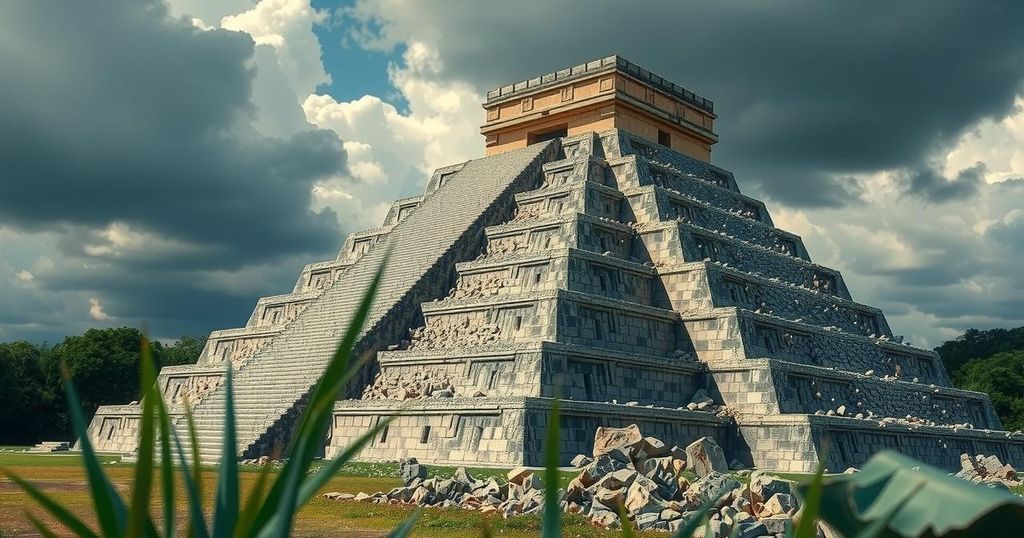Climate Change Threatens Archaeological Heritage: Pyramid in Mexico Collapses
On July 29, 2024, a 15-meter-high pyramid in Michoacán, Mexico, collapsed due to extreme rainfall exacerbated by previous severe drought conditions. This event reflects the broader impact of climate change on cultural heritage sites, with multiple monuments within the archaeological site reported in disrepair. Archaeologists and historians face challenges as they work to preserve these sites in the face of climate-induced risks, emphasizing the urgent need for climate action and preservation efforts.
In a tragic manifestation of climate change’s impact on ancient heritage, a 15-meter-high pyramid situated in Michoacán, Mexico, collapsed due to unprecedented rainfall on July 29, 2024. This pyramid, part of the archaeological site of Ihuatzio, had long been a significant remnant of the Michoacán Kingdom. Recent extreme weather conditions, including a sequence of severe drought followed by intense rainfall, compromised the structural integrity of this and other monuments within the site, with at least six components of the structure reported as being in disrepair. The pyramids, which date back to the occupancy of Nahuatl-speaking peoples over a millennium ago, served as vital cultural legacies, underscoring the extreme vulnerability of these sites in the face of changing environmental conditions. Authorities from Mexico’s National Institute of Anthropology and History (INAH) have indicated that the extensive rains experienced this summer exacerbated pre-existing damage that stemmed from significant drought conditions, which allowed moisture to infiltrate the structure. The ongoing alterations in climate patterns lead to a worrying trend affecting archaeological sites globally, evidenced by deteriorating cave paintings in Oceania and concerns over the preservation of historical structures in Europe due to escalating precipitation. Furthermore, Tariakuiri Alvarez, a representative from the P’urhépecha tribe, reflected on the spiritual significance of such events, noting that his ancestors would have considered such collapses to be ominous, indicative of displeasure from the gods. This escalation of climate-related challenges brings into focus the broader implications of human-induced environmental change on our shared cultural heritage and poses significant threats to humanity’s historical narratives. The plight of the Ihuatzio pyramid serves as a stark warning about the consequences of climatic shifts, highlighting a concerning interplay between current human actions and the preservation of our past. Researchers and archaeologists are now faced with the dual challenge of conducting scholarly work while also addressing these pressing threats to irreplaceable historical treasures. Ultimately, this incident emphasizes the urgency for global policy interventions aimed at mitigating climate change and safeguarding cultural heritage sites, which must be approached with deep respect and a commitment to future generations. This latest event in Ihuatzio follows similar distressing occurrences worldwide, including the collapse of Utah’s ‘Double Arch’, emphasizing a critical pattern that cannot be overlooked.
Heritage sites around the world are increasingly at risk due to the effects of climate change, particularly as extreme weather becomes more frequent and severe. The collapse of the pyramid at Ihuatzio is not a stand-alone incident; rather, it exemplifies a growing trend where ancient structures are compromised by modern climatic shifts, leading to irreparable damage to cultural legacies. Research continues to highlight the vulnerability of archaeological sites, bringing to light the pressing need for both climate action and heritage preservation. As society navigates the repercussions of environmental changes, the importance of safeguarding these historical sites remains paramount, underscoring a shared responsibility to protect our cultural narrative.
The recent collapse of a pyramid in Michoacán, Mexico, illustrates the dire consequences of climate change on cultural heritage sites. With rising global temperatures and increasing extreme weather events, many important historical structures are increasingly at risk. The event not only underscores the immediate threat posed to archaeological treasures worldwide but also serves as a poignant reminder of the need to prioritize climate action to safeguard our shared heritage for future generations. The emotional and cultural significance of such locations cannot be overstated, warranting concerted efforts to address the wider implications of environmental change on humanity’s history.
Original Source: www.sciencealert.com




Post Comment